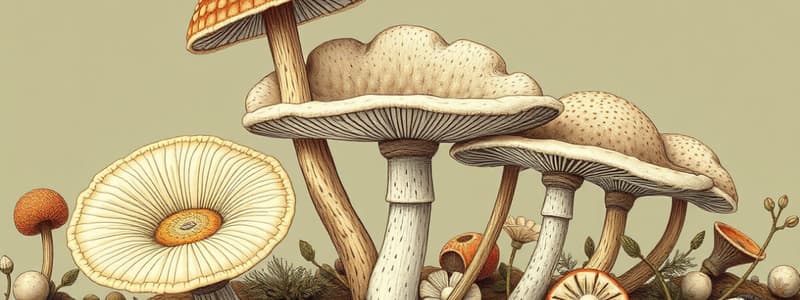Podcast
Questions and Answers
Most of the fungal species are classified into three divisions based on _____
Most of the fungal species are classified into three divisions based on _____
the type of sexual spore produced
Zygomycota produce zygosporangia, Ascomycota produce ascospores, and Basidiomycota produce basidiospores.
Zygomycota produce zygosporangia, Ascomycota produce ascospores, and Basidiomycota produce basidiospores.
True (A)
Fungi and insects both use the nitrogenous polysaccharide ________ as a protective molecule in their outer surfaces.
Fungi and insects both use the nitrogenous polysaccharide ________ as a protective molecule in their outer surfaces.
chitin
Organisms such as fungi that absorb nutrients from dead organisms are called ________.
Organisms such as fungi that absorb nutrients from dead organisms are called ________.
The ________ is the entire interwoven mass of one multicellular fungal organism.
The ________ is the entire interwoven mass of one multicellular fungal organism.
The asexual spores of molds are classified according to their _____
The asexual spores of molds are classified according to their _____
The first eukaryote to have its entire genome sequenced was the fungus?
The first eukaryote to have its entire genome sequenced was the fungus?
Hyphae are associated with _____.
Hyphae are associated with _____.
The division Basidiomycota includes which of the following types of fungi?
The division Basidiomycota includes which of the following types of fungi?
The ___________ include organisms classified as Deuteromycetes.
The ___________ include organisms classified as Deuteromycetes.
Fungi reproduce only asexually.
Fungi reproduce only asexually.
Diseases of animals caused by fungi are called mycoses.
Diseases of animals caused by fungi are called mycoses.
An unknown organism is a saprobe, gathers nutrients by absorption, lacks chlorophyll, has cell walls, and is coenocytic. In which group is it most likely to be classified?
An unknown organism is a saprobe, gathers nutrients by absorption, lacks chlorophyll, has cell walls, and is coenocytic. In which group is it most likely to be classified?
What is the key difference between yeast and mold?
What is the key difference between yeast and mold?
The 4 fungi divisions are _____
The 4 fungi divisions are _____
What is Zygomycota?
What is Zygomycota?
What is Ascomycota/Basidiomycota?
What is Ascomycota/Basidiomycota?
What is Deuteromycetes?
What is Deuteromycetes?
What is Aspergillus?
What is Aspergillus?
What is scopulariopsis?
What is scopulariopsis?
What is hormodendrum?
What is hormodendrum?
What is penicillium notatum?
What is penicillium notatum?
What is rhizopus stolonifer?
What is rhizopus stolonifer?
What is hyphae?
What is hyphae?
What does the hyphae make up?
What does the hyphae make up?
What is vegetative hyphae?
What is vegetative hyphae?
What are cadiospores?
What are cadiospores?
What are phialospores?
What are phialospores?
What are sporangiospores?
What are sporangiospores?
Molds are?
Molds are?
What is Candida albicans?
What is Candida albicans?
Fungi yeasts are?
Fungi yeasts are?
What type of mold spores does Penicillium notatum produce?
What type of mold spores does Penicillium notatum produce?
What do you use to stain mold?
What do you use to stain mold?
Flashcards
Zygomycota
Zygomycota
Fungi division producing zygosporangia.
Ascomycota
Ascomycota
Fungi division creating ascospores.
Basidiomycota
Basidiomycota
Fungi division that produces basidiospores.
Chitin
Chitin
Signup and view all the flashcards
Saprobes
Saprobes
Signup and view all the flashcards
Mycelium
Mycelium
Signup and view all the flashcards
Hyphae
Hyphae
Signup and view all the flashcards
Conidiospores
Conidiospores
Signup and view all the flashcards
Phialospores
Phialospores
Signup and view all the flashcards
Sporangiospores
Sporangiospores
Signup and view all the flashcards
Molds
Molds
Signup and view all the flashcards
Vegetative hyphae
Vegetative hyphae
Signup and view all the flashcards
Lactophenol cotton blue
Lactophenol cotton blue
Signup and view all the flashcards
Yeasts
Yeasts
Signup and view all the flashcards
Candida albicans
Candida albicans
Signup and view all the flashcards
Aerial hyphae
Aerial hyphae
Signup and view all the flashcards
Deuteromycetes
Deuteromycetes
Signup and view all the flashcards
Rhizopus
Rhizopus
Signup and view all the flashcards
Saccharomyces
Saccharomyces
Signup and view all the flashcards
Aspergillus
Aspergillus
Signup and view all the flashcards
Scopulariopsis
Scopulariopsis
Signup and view all the flashcards
Study Notes
Fungal Classification
- Fungi are categorized into three divisions based on the type of sexual spore produced.
- Key divisions: Zygomycota (zygosporangia), Ascomycota (ascospores), and Basidiomycota (basidiospores).
Fungal Characteristics
- Chitin is a nitrogenous polysaccharide found in the outer surfaces of fungi and insects.
- Saprobes are organisms that absorb nutrients from decaying matter.
- Mycelium refers to the entire interwoven mass of a multicellular fungal organism.
- Hyphae are threadlike tubes that make up the body structure of molds.
Fungal Reproduction
- Fungi are capable of both sexual and asexual reproduction.
- Asexual spores of molds are classified by their mode of development.
Key Fungal Groups
- Basidiomycota includes fungi such as mushrooms and truffles.
- Deuteromycetes represent fungi that do not produce known sexual spores.
- Common mold (Zygomycota) thrives in soil and decaying organic material.
Notable Fungi
- Saccharomyces was the first eukaryote to have its entire genome sequenced.
- Aspergillus generates phialospores and resembles a firework display.
- Scopulariopsis produces porospores and appears as dots in a chain.
Sexual and Asexual Spores
- Candiospores are naked spores without protective structures.
- Phialospores are asexual naked spores produced on specialized cells called sterigmata.
- Sporangiospores are formed within a sporangium at the end of an aerial hypha (sporangiophore) and can originate from Rhizopus.
General Fungal Structure
- Molds are multicellular and exhibit different types of hyphae: vegetative (thallus) and aerial (reproductive).
- Vegetative hyphae secrete enzymes to break down complex carbohydrates.
Staining and Identification
- Lactophenol cotton blue is used to stain mold samples for microscopic examination.
Unique Characteristics of Yeasts
- Yeasts are unicellular fungi reproducing asexually by budding but can also form sexual spores.
- Candida albicans can develop pseudohyphae and produce germ tubes during serum testing.
Studying That Suits You
Use AI to generate personalized quizzes and flashcards to suit your learning preferences.




